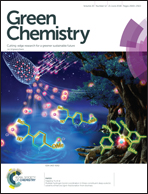Abstract
Hydrogenolysis of cork has been examined using a range of precious metal catalysts studying the effect of the support, added base and solvent used. The addition of a catalyst and a base resulted in a bio-oil increase of 9.3–158% compared to when no catalyst was used along with an increase in the lipid yield of 113–258%. The change in the solvent to 2-methyl tetrahydrofuran from the original dioxane solvent system allowed for a change to a “greener” solvent as well as an increased bio-oil yield from 11.5 wt% to 42.6 wt%, in the absence of a base.



 Please wait while we load your content...
Please wait while we load your content...